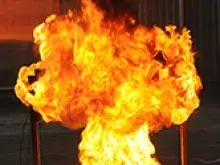 (November 25, 2009) It would be unthinkable to build an aircraft today without a black box, the well-known recording device installed on airplanes that can provide clues to investigators when tragedy strikes. Yet when it comes to trains, buses and subways, such a device has been non-existent.
(November 25, 2009) It would be unthinkable to build an aircraft today without a black box, the well-known recording device installed on airplanes that can provide clues to investigators when tragedy strikes. Yet when it comes to trains, buses and subways, such a device has been non-existent.
That may soon change, as seen in the latest Department of Homeland Security (DHS) demonstration of forensic cameras.
The project began when state and local officials expressed a need to replicate the black box concept of the airways on railways and highways. They wanted some sort of video record to provide information in the event of a crash. The challenge: to repurpose hardened data-storage technology for mass production at a reasonable price.
Tapping the resources of the marketplace, the Department sought ideas through the innovative public-private partnership known as System Efficacy through Commercialization, Utilization, Relevance and Evaluation (SECURE). Two companies submitted prototypes.
Phase one of testing took place in February. The forensic cameras were wired to the inside of a bus. The bus was then detonated to determine if the cameras' memory chips could withstand the massive explosion. In seven of eight tests, the chips remained intact, paving the way for phase two—a simulation of the intense, sustained heat that would likely be found in a burning vehicle.
In early October, a group of Science and Technology Directorate (S&T) staff and representatives from companies submitting prototypes witnessed the results.
In the middle of a hangar at Aberdeen Providing Ground in Maryland, an engineer poured diesel fuel into an open steel box. Two ruggedized prototypes were bolted to a horizontal bracket above the box. Inside these prototypes were the all-important memory chips.
Within seconds, the orange flame climbed to seven feet. Soon its heat reached over 1,700 degrees Fahrenheit. After eight minutes of intense heat, the controlled conflagration was snuffed. The prototypes were sprayed with water, which cooled them to a mere 100 degrees within a minute.
Even under these extraordinary circumstances, at least one of the data chips—and its gigabytes of video data—could be tested onsite. "Everything inside was incredibly pristine," beamed S&T program manager Stephen Dennis, noting that every byte of prerecorded data was accounted for. The second chip will require further analysis offsite.
"What special material was used to fortify the lucky prototype?" Dennis asked one of the manufacturers.
"Buy 10,000 cameras," came the wink-and-nod reply, "and we'll tell you."
To request more information about this story, please e-mail st.snapshots@hq.dhs.gov.
